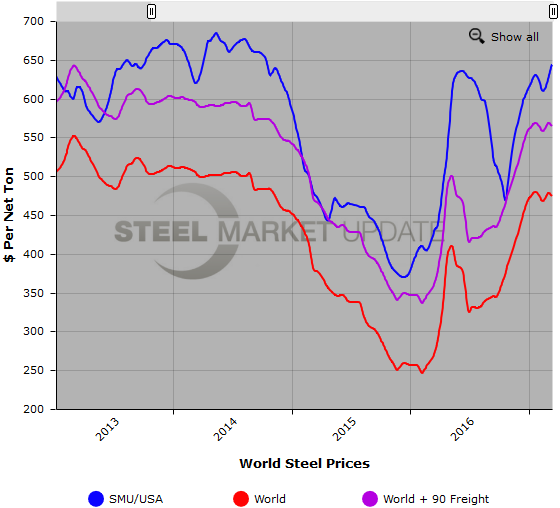International Steel Prices

Analysis of Foreign vs. Domestic Hot Rolled Coil Prices
Written by Brett Linton
March 16, 2017
The following calculation is used by Steel Market Update to identify the theoretical spread between foreign hot rolled steel export prices and domestic (USA) hot rolled coil prices. We want our readers to note that we have made a decision to replace SteelBenchmarker as the primary data provider of foreign hot rolled coil prices. We were finding the comparison between Platts European (Ruhr) number (as well as other Platts foreign export numbers) to be much closer to the actual quotes we are seeing on HRC out of various steel trading companies than using the SteelBenchmarker “world export” number we did previously. We will continue to use SteelBenchmarker as a secondary number provider which we will note further down in this article.
Our primary numbers for this exercise are from Platts, with a comparison of European HRC (FOB Ruhr), Turkey HRC export pricing (FOB Turkey), and Chinese HRC export prices (FOB Chinese port). Be aware that Chinese hot rolled is not available to the U.S. market so the Chinese spread is nothing more than an exercise of what if…
![]() SMU adds $90 per ton to these foreign prices taking into consideration freight costs, handling, trader margin, etc. This provides an approximate “to the US ports price” that can then be compared against the SMU US hot rolled price average (FOB Mill), with the result being the spread (difference) between domestic and foreign hot rolled prices. As the price spread narrows, the competitiveness of imported steel into the United States is reduced. If the spread widens, then foreign steel becomes more attractive to US flat rolled steel buyers. A positive spread means US prices are theoretically higher than foreign prices, while a negative spread means US prices are cheaper than foreign prices.
SMU adds $90 per ton to these foreign prices taking into consideration freight costs, handling, trader margin, etc. This provides an approximate “to the US ports price” that can then be compared against the SMU US hot rolled price average (FOB Mill), with the result being the spread (difference) between domestic and foreign hot rolled prices. As the price spread narrows, the competitiveness of imported steel into the United States is reduced. If the spread widens, then foreign steel becomes more attractive to US flat rolled steel buyers. A positive spread means US prices are theoretically higher than foreign prices, while a negative spread means US prices are cheaper than foreign prices.
As of today (Thursday, March 16th) Platts published European HRC prices at $557 per net ton ($573 Euros per metric ton), up $11 from two weeks ago and unchanged from one month ago. Calculating in $90 per ton for import costs, that puts prices at $647 per net ton from Europe delivered to the US. The latest Steel Market Update hot rolled price average is $645 per ton for domestic steel, up $20 per ton compared to the last time we did an update on world prices on March 2nd, and up $35 per ton over one month ago. This puts the theoretical spread between European and US HR prices at -$2 per ton, up from -$11 two weeks ago, and up from -$37 one month ago. This means that currently US sourced HR is theoretically $2 per ton cheaper to buy than getting HR steel imported from Europe.
Chinese HRC prices were reported at $483 per net ton ($533 per metric ton), up $19 from two weeks ago and up $32 over one month ago. Adding $90 in estimated import costs, that puts prices around $573 per ton delivered from China (if China were able to ship to the United States, which they are not). The theoretical spread between the Chinese and US HR price is +$72 per ton, up from +$71 per ton two weeks ago and up from +$69 per ton one month ago. Meaning that if Chinese HR were able to be shipped to the US, it would be $72 per ton cheaper than buying domestic steel.
Platts published Turkish export prices at $454 per net ton FOB Turkish port ($500 per metric ton), down $22 over two weeks ago and down $18 from one month ago. Adding $90 in import costs, the Turkish HRC “to the US ports” price is $544 per ton. This puts the theoretical spread between the Turkish and US HR price at +$101 per ton, up from +$59 two weeks ago and up from +$48 one month ago. This means that HR from the US is theoretically $101 per ton more expensive than importing HR from Turkey.
Please note that this is a “theoretical” calculation as freight costs, trader margin and other costs can fluctuate ultimately influencing the true market spread. And again, the Chinese spread is nothing more than an exercise of what if…
SMU Note: Just before we published we got a Turkish HRC number into the US Gulf Port – that number was $600 per ton (plus any applicable extras) which is $56 per ton higher than our “theoretical” calculation shown above.
SteelBenchmarker World Export Price
The SteelBenchmarker world export price for hot rolled bands is $475 per net ton ($524 per metric ton) FOB the port of export according to data released by SteelBenchmarker on Monday March 13th. This is down $3 per ton from the previous release on February 27th but up $8 from one month ago. Adding in $90 in estimated import costs, that puts prices around $565 per ton delivered to the US. Like we previously mentioned, the latest Steel Market Update hot rolled price average is $645 per ton.
Therefore, the theoretical spread between the SteelBenchmarker world HR export price and the SMU HR price is +$80 per ton, meaning foreign steel imported into the US is theoretically now $80 per ton cheaper than domestic steel. This spread is up from +$57 from our previous analysis and down from +$52 one month ago.
This $80 spread is about $20 per ton higher than what we have seen over the last few months. Over the summer of 2016, we had record high spreads, with the June 27th 2016 spread of $210 being the record high in our 7+ year recorded history, and the July 14th 2016 spread of $204 being the second highest. Prior to 2016, the previous highest spread was $94 in May 2014. The lowest spread in our history was -$70 in August 2011 (meaning domestic steel was theoretically $70 per ton cheaper than foreign steel). This time last year, the spread was $69 per ton.
Freight is an important part of the final determination on whether to import foreign steel or buy from a domestic mill supplier. Domestic prices are referenced as FOB the producing mill while foreign prices are FOB the Port (Houston, NOLA, Savannah, Los Angeles, Camden, etc.). Inland freight, from either a domestic mill or from the port, can dramatically impact the competitiveness of both domestic and foreign steel.
Below is a graph comparing SteelBenchmarker world HR export prices against the SMU domestic HR average price (we will build new data using Platts and replace the SteelBenchmarker data once we have collected a sizable history). We also have included a comparison with freight and traders’ costs added which gives you a better indication of the true price spread. You will need to view the graph on our website to use it’s interactive features, you can do so by clicking here. If you need assistance with either logging in or navigating the website, please contact us at 800-432-3475 or info@SteelMarketUpdate.com.

Brett Linton
Read more from Brett LintonLatest in International Steel Prices
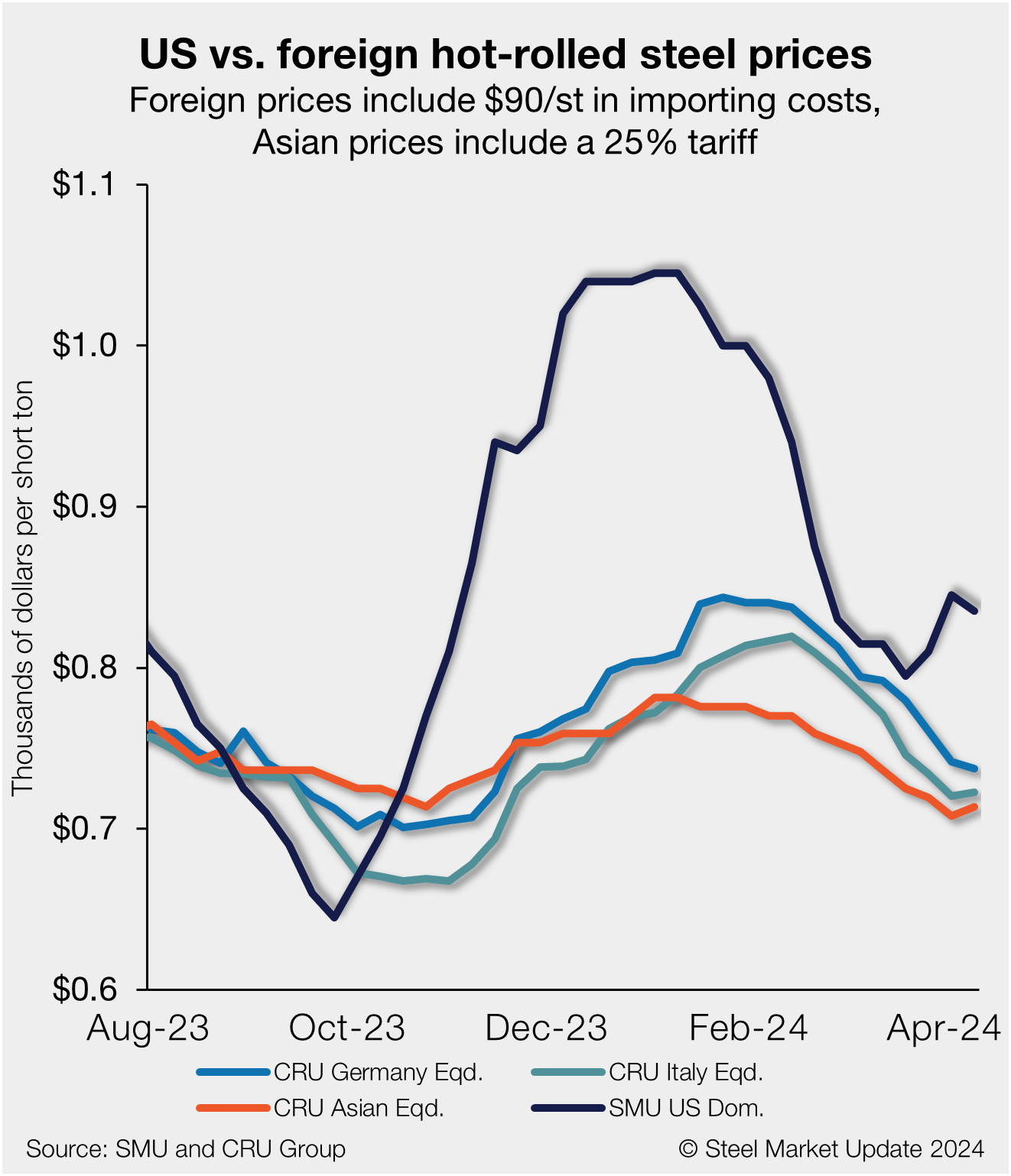
US HR prices slip, though still more expensive than imports
US hot-rolled (HR) coil has become increasingly more expensive than offshore hot band as stateside prices have moved higher at a sharper pace vs. imports.
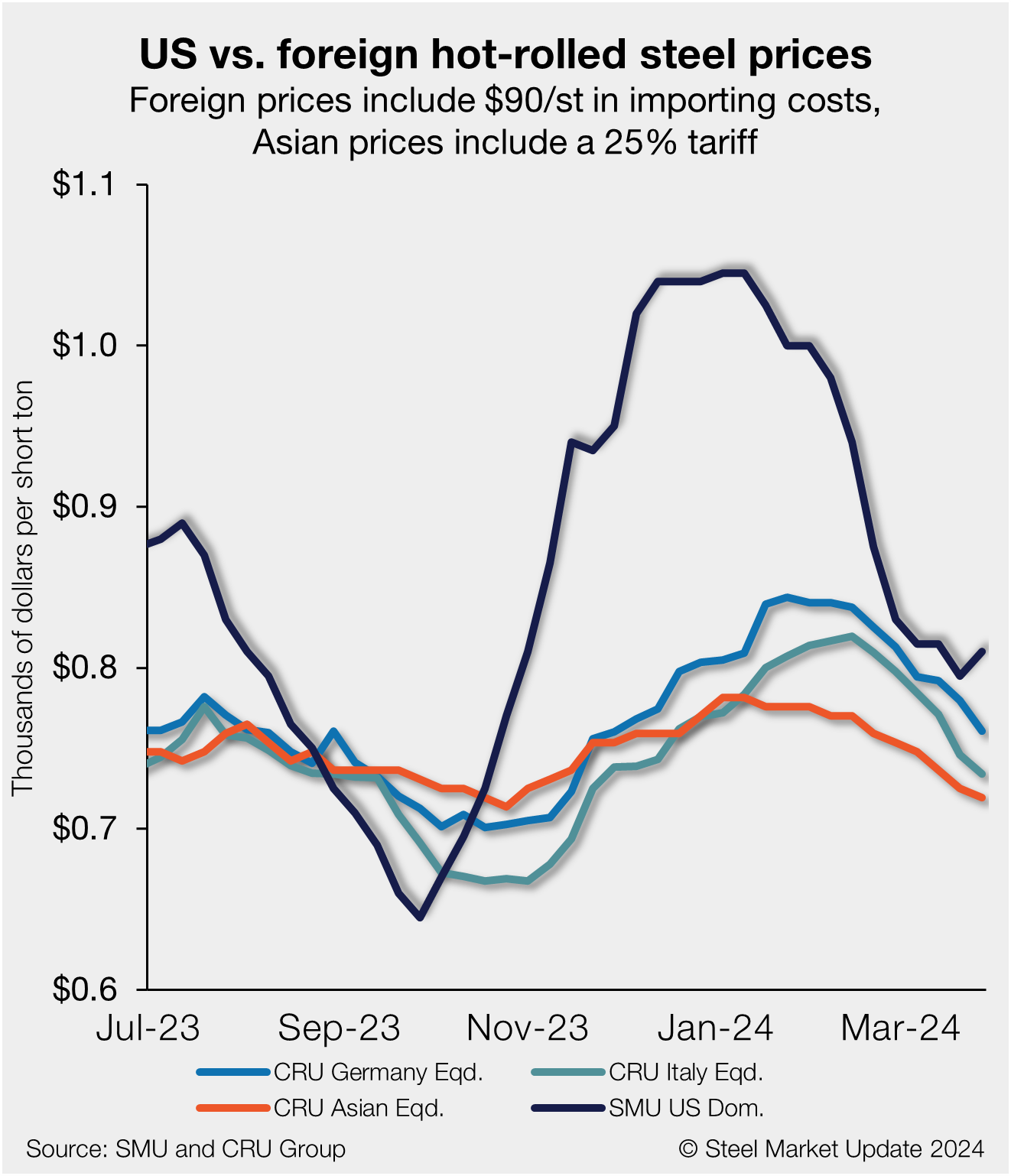
US HR prices rebound, no longer near parity with imports
US hot-rolled coil and offshore hot band moved further away from parity this week as stateside prices have begun to move higher in response to mill increases.
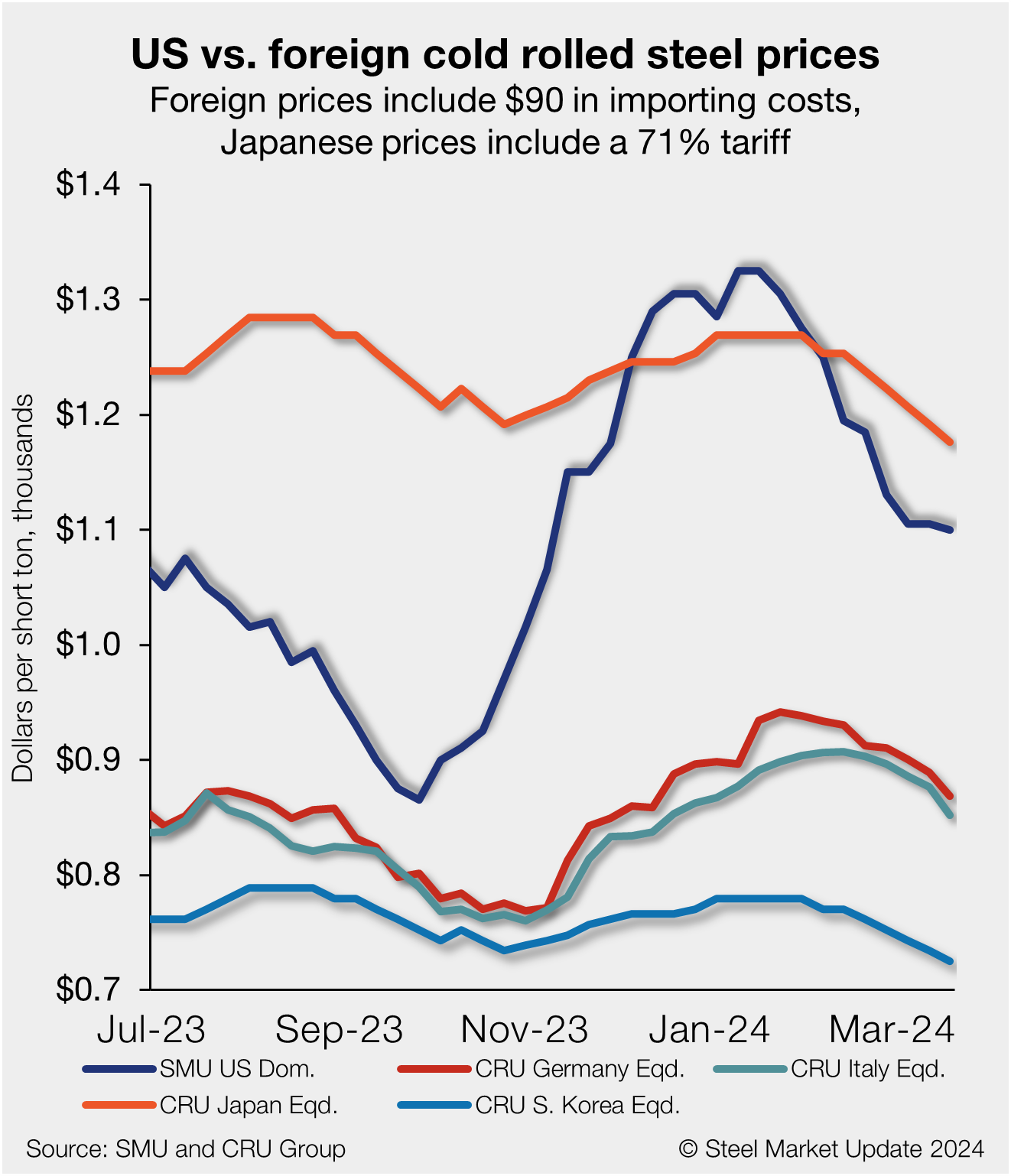
US cold rolled still more expensive than imports
Foreign cold-rolled (CR) coil remains notably less expensive than domestic product even with repeated tag declines across all regions, according to SMU’s latest check of the market.
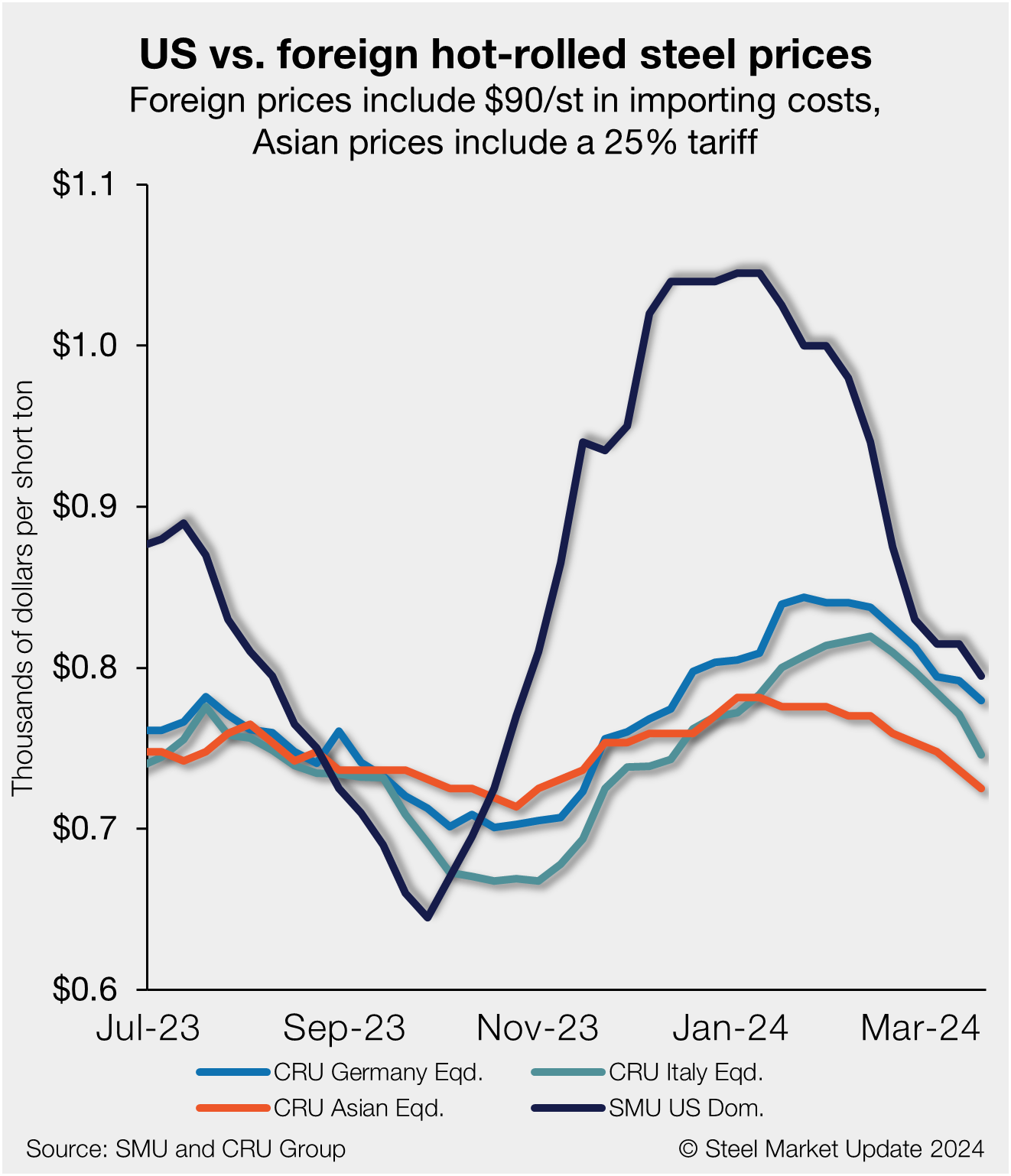
US HRC prices slowly inch toward parity with imports
US hot-rolled coil (HRC) remains more expensive than offshore hot band but continues to move closer to parity as prices decline further. The premium domestic product had over imports for roughly five months now remains near parity as tags abroad and stateside inch down.
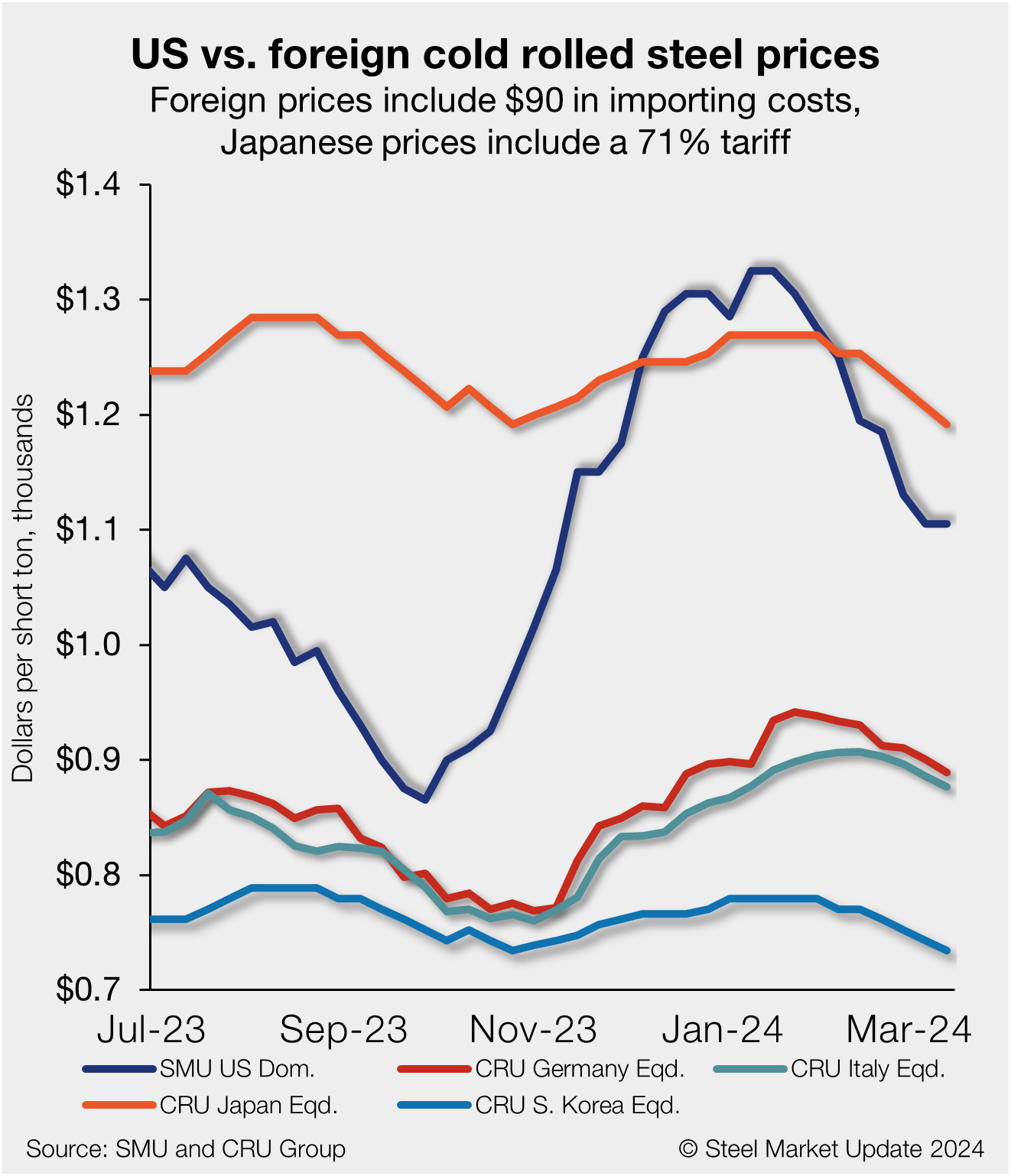
US cold rolled still more expensive than offshore product
Foreign cold-rolled coil (CR) remains significantly less expensive than domestic product even as US tags continue to decline in a hurry, according to SMU’s latest check of the market.

